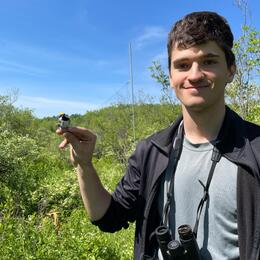What’s good for birds is good for people.
That is why Audubon Vermont is proud to support the 2023 Environmental Common Agenda. Created by the Vermont Conservation Voters with input from environmental organizations across the state, the Common Agenda identifies policies that lawmakers can prioritize to secure a more resilient, just, and biodiverse Vermont.
Read on to learn more about the Common Agenda’s three overarching goals for this legislative session, each of which serves people and birds alike by recognizing nature as a fundamental need we share.
Goal 1: Ensure clean and affordable heating, transportation, and electricity for all Vermonters.
Climate change is one of the biggest threats to the birds that we love. Audubon’s Survival by Degrees report shows that two-thirds of North American bird species are at risk of extinction from climate-related threats, such as warm winters, spring heat waves, droughts, heavy rainfall, and sea level rise. In Vermont alone, 94 species were found to be vulnerable to climate change, including the Common Loon, Hermit Thrush, Bobolink, and Black-throated Green Warbler. Reducing our carbon emissions will slow and dampen the effects of climate change, ensuring a place for birds in the future of our state.
More than 70 percent of Vermont’s greenhouse gas pollution comes from transportation and heating. Establishing regulatory tools to curtail emissions in these sectors represents our fastest path to reducing emissions statewide by 40 percent by 2030 and 80 percent by 2050, as mandated by the Global Warming Solutions Act in 2020 and prioritized by the 2021 Climate Action Plan. Powering our electrical grid entirely with local, clean, and properly sited renewable energy will further advance our efforts to combat climate change in Vermont, for the benefit of people and birds.
Goal 2: Build more climate-resilient communities by adopting smart growth housing strategies while better protecting our waters, forests, and wildlife.
There is perhaps no place where the needs of Vermont’s birds and people converge more directly than on working farms and forests. Birds depend on open lands for food and nesting sites; people depend on them for food, wood, vibrant rural economies, and more. And as climate change becomes a local reality, birds and people will increasingly depend on Vermont’s working and natural lands to avoid the worst effects and prepare for what’s to come.
Smart growth housing aims to protect these invaluable resources by funneling new development into affordable, livable, and walkable communities in downtowns and village centers. This strategy simultaneously reduces climate pollution and preserves the capacity of natural lands to sequester and store carbon. For all the climate impacts that we can’t prevent, intact forests, fields, and wetlands provide flood control, water filtration, shady refuge, and safe migration pathways, creating resilient human and avian communities.
From clean drinking water, diverse wildlife habitat (e.g., in forests and riparian areas), and a reliable food supply to recreational opportunities, state-defining views, and cultural pride, Vermont has a lot to lose with the reckless development of its working and natural lands. Supporting and protecting these areas is therefore critical for Vermont to sustain its current and future residents, feathered or otherwise, amid rapid environmental change.
Goal 3: Promote a healthy Vermont.
The rapid cascade of toxic chemicals across the environment and food chain reveals the profound interconnectedness of all living things—but not without a devastating cost. PFAs, for example, can cause developmental issues, cancers, and other diseases in fish, birds, and humans. Expanding restrictions on PFAs in Vermont will protect our public health while removing one more obstacle from the mighty task of being a bird. Reducing our reliance on single-use plastics and other harmful materials will further give birds and other wildlife a fighting chance.
A healthy, equitable, and biodiverse Vermont depends on a robust democracy. Birds can't vote, but we can. Audubon Vermont’s thousands-strong membership proves that Vermonters care about creating a hospitable world for humans and wildlife both. Ensuring that these voices are heard at the local, state, and federal levels is paramount to our collective ability to speak up for the birds.
For more information on the Common Agenda and specific proposed legislation, see Vermont Conservation Voters’ full 2023 Environmental Common Agenda: click here.








